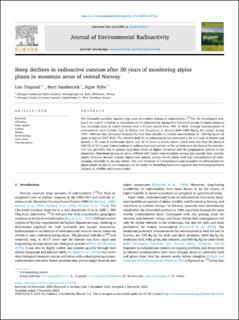| dc.contributor.author | Tingstad, Lise | |
| dc.contributor.author | Sandercock, Brett Kevin | |
| dc.contributor.author | Nybø, Signe | |
| dc.coverage.spatial | Central Norway | en_US |
| dc.date.accessioned | 2023-12-12T12:01:43Z | |
| dc.date.available | 2023-12-12T12:01:43Z | |
| dc.date.created | 2023-12-11T13:10:08Z | |
| dc.date.issued | 2023 | |
| dc.identifier.issn | 0265-931X | |
| dc.identifier.uri | https://hdl.handle.net/11250/3107096 | |
| dc.description.abstract | The Chernobyl accident exposed large areas of northern Europe to radiocaesium (137Cs). We investigated temporal and spatial variation in concentrations of radiocaesium among five functional groups of alpine plants at two mountain areas in central Norway over a 31-year period from 1991 to 2022. Average concentrations of radiocaesium were initially high in lichens and bryophytes at around 4600–6400 Bq/kg dry weight during 1991–1994 but then decreased dramatically over three decades to current concentrations of <200 Bq/kg for all plant groups in 2019–2022. The effective half-life of radiocaesium was estimated to be 4–6 years in lichens and mosses, 7–13 years in herbaceous plants, and 22–30 years in woody plants, which were less than the physical half-life of 30.2 years. Concentrations of radiocaesium were greater at the nutrient-poor site than at the nutrientrich site, probably due to greater deposition levels at higher elevations and the geographical pattern of the deposition. Functional groups of plants differed with higher concentrations among non-vascular than vascular plants. Common heather Calluna vulgaris was unusual among woody plants with high concentration of radiocaesium, especially in the new shoots. Our new estimates of concentrations and dynamics of radiocaesium for alpine plants in natural environments will be useful for modelling herbivore exposure and evaluating potential impacts on wildlife and human health. Chernobyl Plant uptake Lichens Mosses Radiocaesium Time series Vascular plants | en_US |
| dc.language.iso | eng | en_US |
| dc.rights | Navngivelse 4.0 Internasjonal | * |
| dc.rights.uri | http://creativecommons.org/licenses/by/4.0/deed.no | * |
| dc.subject | Chernobyl | en_US |
| dc.subject | Plant uptake | en_US |
| dc.subject | Lichens | en_US |
| dc.subject | Mosses | en_US |
| dc.subject | Radiocaesium | en_US |
| dc.subject | Time series | en_US |
| dc.subject | Vascular plants | en_US |
| dc.title | Steep declines in radioactive caesium after 30 years of monitoring alpine plants in mountain areas of central Norway | en_US |
| dc.title.alternative | Steep declines in radioactive caesium after 30 years of monitoring alpine plants in mountain areas of central Norway | en_US |
| dc.type | Peer reviewed | en_US |
| dc.type | Journal article | en_US |
| dc.description.version | publishedVersion | en_US |
| dc.rights.holder | © 2023 The Authors | en_US |
| dc.subject.nsi | VDP::Matematikk og Naturvitenskap: 400::Zoologiske og botaniske fag: 480 | en_US |
| dc.source.volume | 272 | en_US |
| dc.source.journal | Journal of Environmental Radioactivity | en_US |
| dc.identifier.doi | 10.1016/j.jenvrad.2023.107352 | |
| dc.identifier.cristin | 2211736 | |
| dc.relation.project | Norges forskningsråd: 160022 | en_US |
| dc.source.articlenumber | 107352 | en_US |
| cristin.ispublished | true | |
| cristin.fulltext | original | |
| cristin.qualitycode | 1 | |

